
The Merdeka Palace, is one of six presidential palaces in Indonesia. It is located on the north side of the Merdeka Square in Central Jakarta, Indonesia, and is used as the official residence of the president of the Republic of Indonesia.

Raden Saleh Sjarif Boestaman was a pioneering Romantic painter from the Dutch East Indies of Arab-Javanese ethnicity. He was considered to be the first "modern" artist from Indonesia, and his paintings corresponded with nineteenth-century romanticism which was popular in Europe at the time. He also expressed his cultural roots and inventiveness in his work.

Menteng is a district in the administrative city of Central Jakarta, Indonesia. Menteng is surrounded by the districts of Senen and Matraman to the east, Tebet and Setiabudi to the south, Tanah Abang to the west, and Gambir to the north. Menteng is bound by the West Flood Canal to the west, Ciliwung River to the south and east, and Kebon Sirih Road to the north. Menteng is the district seat of the Central Jakarta government.

Pasar Minggu is a district in the administrative city of South Jakarta, Indonesia. The area is known for its traditional Sunday market, famous for the fruit market. Historically, Pasar Minggu is a fruit cultivation area developed by the Dutch government during the colonial period. The central point of the cultivation area is the traditional market of Pasar Minggu, located in what is now the lower-division Pasar Minggu subdistrict. Teak forest could also be found in the Pasar Minggu district, notably around the Jati Padang subdistrict. Most of these areas have been converted into residential areas as Jakarta grows southward.

Sawah Besar is a district (kecamatan) of Central Jakarta, Indonesia. Its neighborhoods are among the most historic, containing the 1820-established Pasar Baru, the new colonial city – Weltevreden – and the old course of the Ciliwung river. Landmarks include the Lapangan Banteng, the government's 19th century-built, low-rise A.A. Maramis Building and its high palmed-lawned vista, and Jakarta Cathedral.

Kebayoran Baru is a district in the administrative city of South Jakarta, Indonesia. The name was derived from a planned satellite city of the same name which was developed in the post-war period. Kebayoran Baru was the last residential area to be developed by the Dutch colonial administration. The urban planning was laid in a concept of the Garden city movement, consisting of a well-planned residential area, a shopping center, and a business district, supported with civic facilities such as schools, places of worship, hospitals, and parks. Today, the district is home to many important government institutions, such as the Indonesia Stock Exchange building, the ASEAN Headquarters building, the National Police headquarters, and the City Hall of South Jakarta. Sudirman Central Business District is also located in the district.
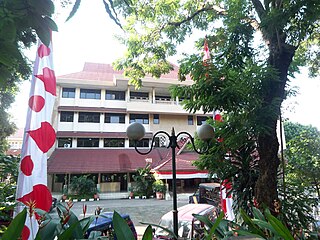
Tebet is a district in the administrative city of South Jakarta, Indonesia. The boundaries of Tebet are Jend. Gatot Subroto-Letjen Haryono MT. tollway to the south, Ciliwung River to the east, Jalan Casablanca - Ciliwung River to the north, and Cideng River to the west. This district is home to SMA Negeri 8 Jakarta
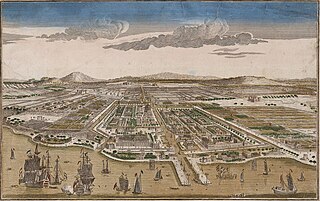
Jakarta is Indonesia's capital and largest city. Located on an estuary of the Ciliwung River, on the northwestern part of Java, the area has long sustained human settlement. Historical evidence from Jakarta dates back to the 4th century CE, when it was a Hindu settlement and port. The city has been sequentially claimed by the Indianized kingdom of Tarumanegara, the Hindu Kingdom of Sunda, the Muslim Sultanate of Banten, and by Dutch, Japanese and Indonesian administrations. The Dutch East Indies built up the area before it was taken during World War II by the Empire of Japan and finally became independent as part of Indonesia.

The colonial architecture of Indonesia refers to the buildings that were created across Indonesia during the Dutch colonial period, during that time, this region was known as the Dutch East Indies. These types of colonial era structures are more prevalent in Java and Sumatra, as those islands were considered more economically significant during the Dutch imperial period. As a result of this, there is a large number of well preserved colonial era buildings that are still densely concentrated within Indonesian cities in Java and Sumatra to this day.

Colonial buildings and structures in Jakarta include those that were constructed during the Dutch colonial period of Indonesia. The period succeeded the earlier period when Jakarta, governed by the Sultanate of Banten, were completely eradicated and replaced with a walled city of Batavia. The dominant styles of the colonial period can be divided into three periods: the Dutch Golden Age, the transitional style period, and Dutch modernism. Dutch colonial architecture in Jakarta is apparent in buildings such as houses or villas, churches, civic buildings, and offices, mostly concentrated in the administrative city of Central Jakarta and West Jakarta.

Ismail Marzuki Park,, is an arts, cultural, and science center located at Cikini in Jakarta, Indonesia. Taman Ismail Marzuki complex comprises several facilities including six performing arts theaters, cinemas, an exhibition hall, a gallery, libraries, and an archive building. The complex is built on a 9-hectare land area, which was previously a zoo. TIM is named after Ismail Marzuki, one of Indonesia's most influential composers.
Frans Johan Louwrens Ghijsels was a Dutch architect and urban planner who worked in the Netherlands and the Dutch Indies. Ghijsels was the founder of AIA, the biggest architecture consultant in the Dutch Indies. He was one of the instrumental architects in developing a modern style characteristic of the Dutch Indies.

Kebon Sirih is the northernmost administrative village of Menteng district of Jakarta. It has a postal code of 10340. Kebon Sirih is located to the south of Monas - a historic administrative center of Jakarta - and to the north of Menteng Residential Area - a heritage garden city. The boundary is Jalan KH Wahid Hasyim-Jalan Johar, Jalan Pengarengan to the south, Ciliwung River to the east, Jalan Kebon Sirih to the north, and Jalan Kampung Bali I. 33-Terusan Kebon Sirih 14 to the west.

The Kunstkring Art Gallery is a heritage building located in Central Jakarta, Indonesia. Built in 1914, following the design of Dutch architect P.A.J. Moojen, it originally housed the local art circle. After several changes of use, in 2011 the building has been restored, with the upper floor used as an art gallery while the ground floor has been converted into a restaurant.
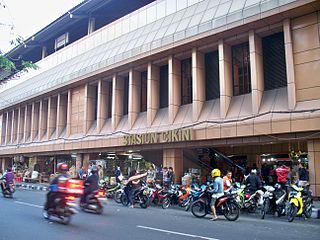
Cikini Station is a railway station located on Jl. Cikini Raya, Cikini, Menteng, Jakarta. This station is only served by KRL Commuterline commuter trains from Jakarta Kota to Depok and Bogor.
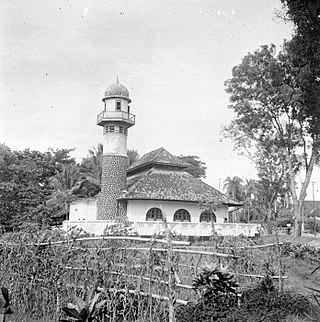
Masjid Jami' Al-Makmur Cikini is located on Jalan Raden Saleh Raya in Cikini, Central Jakarta, and is one of the oldest mosques in the locality. It was formerly known as Tjikini Mosque.

Primaya Hospital PGI Cikini, also known as PGI Cikini Hospital or Cikini Hospital, is a hospital in Cikini, Menteng in Jakarta, Indonesia. It was formerly a mansion that was designed by Indonesian painter Raden Saleh, who used it as residence. Use of it as a hospital and nursing academy began in 1898. The building was built in 1852 and is known for its park-like setting in busy Jakarta, and was home to antelope until they were removed in the early 1970s. Saleh once had a collection of wild animals on the property. It has design features similar to the Callenberg Castle.

Indies Empire style is an architectural style that flourished in the colonial Dutch East Indies between the middle of the 18th century and the end of the 19th century. The style is an imitation of the neoclassical Empire Style which was popular in mid-19th-century France. Conformed to the tropical setting of Indonesia, the style became known in the Dutch East Indies as the Indies Empire style.
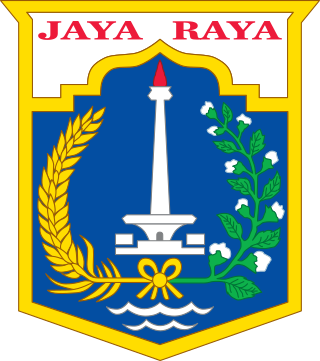
The following outline is provided as an overview of and topical guide to Jakarta:
Gedung Joang '45 is a historical museum in Jakarta, which tells the history of the Indonesian struggle for independence from Dutch colonial rule and the formation of the state of Indonesia.























